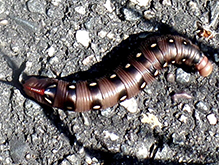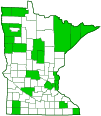galium sphinx
(Hyles gallii)
Conservation • Description • Habitat • Ecology • Distribution • Taxonomy
|
|
||||||||||||||||||
Description |
Galium sphinx, also called bedstraw hawkmoth, is a large moth but a small sphinx moth. It occurs around the globe in temperate regions of the Northern Hemisphere. In the United States it occurs as far south as Iowa. It is common and increasing in the east from Connecticut to Pennsylvania. It is not uncommon in Minnesota. It is found in forest edges, meadows, roadsides, and gardens. Adults are 1½″ to 2″ (38 to 50 mm) long and have a wingspan of 2 9 ⁄16″ to 3 1 ⁄16″ (64 to 78 mm). The forewing is long and narrow with a smooth forward (costal) margin, a convex outer margin, and a slightly concave inner margin. The upperside is dark olive brown near the costal and inner margins, blackish-gray toward the center. A narrow tan band extends diagonally from the inner margin near the base to the wing tip. The veins are inconspicuous, dark in the tan stripe, brown and slightly lighter in the dark areas. Unlike the closely-related white-lined sphinx, there are no white streaks along the veins. There is a pale spot in the basal area and a small, irregular, white patch in the median area. The hindwing is blackish gray with a pale fringe and a broad, deep pink band extending diagonally from the inner margin near the body to the outer margin near the apex. The head and thorax are dark olive brown. A thin white stripe on each side of the head extends along the side of the thorax. The antenna is thickened and club-like. The proboscis is long and is coiled under the head when not in use. The caterpillar is up to 2¾″ long. The background color is highly variable. It is usually brown or black, sometimes green. There are often small, yellow, vertically aligned spots on the sides. On some individuals, these spots densely cover the entire body. There is large yellowish spot on each side in the subdorsal area of the third segment of the thorax and on abdominal segments 1 through 8. These spots are usually broadly surrounded with black. A stout, bright red horn extends from the middorsal surface of the eighth abdominal segment. The breathing pores (spiracles) on each lower side of each abdominal segment are pale with a narrow black border. The head, prothoracic shield, and anal plate are always the same color, usually reddish, sometimes lavender-purple. Mature caterpillars can be found from mid-August to October. |
Size |
Total length: 1½″ to 2″ (38 to 50 mm) Wingspan: 2 9 ⁄16″ to 3 1 ⁄16″ (64 to 78 mm) |
Similar Species |
Habitat |
Forest edges, meadows, roadsides, gardens |
Ecology |
Season |
One generation: May through August |
Behavior |
Adults are active from late afternoon through the night. They are attracted to light. |
Life Cycle |
The female lays eggs on the leaves of host plants. Pupa overwinter in the ground. |
Larva Hosts |
Bedstraw (Galium spp.), willowherb (Epilobium spp.), and fireweed (Chamerion spp.) |
Adult Food |
Flower nectar |
Distribution |
||
|
Sources 21, 24, 29, 30, 71, 75, 82, 83. Biodiversity occurrence data published by: Minnesota Biodiversity Atlas (accessed through the Minnesota Biodiversity Atlas Portal, bellatlas.umn.edu, 8/14/2025). |
|
| 8/14/2025 | ||
Occurrence |
||
Not uncommon in Minnesota |
||
Taxonomy |
|
Order |
|
Superfamily |
Bombycoidea (Hawk, Sphinx, Silk, Emperor, and Allied Moths) |
Family |
|
Subfamily |
Macroglossinae |
Tribe |
Macroglossini |
Subtribe |
Choerocampina |
Genus |
Hyles |
Subordinate Taxa |
|
|
|
Synonyms |
|
Celerio chishimana Celerio gallii Celerio nepalensis Celerio sachaliensis Celerio tibetanica Deilephila chamaenerii Deilephila galii Deilephila intermedia Deilephila oxybaphi Hyles canadensis Hyles chamaenerii Hyles chishimana Hyles cuspidata Hyles dentata Hyles epilobii Hyles esulae Hyles flavescens Hyles galii Hyles gallii gallii Hyles gallii intermedia Hyles grisea Hyles grisescens Hyles heliophila Hyles incompleta Hyles intermedia Hyles jacobsi Hyles lata Hyles lutea Hyles maculifera Hyles nepalensis Hyles oxybaphi Hyles pallida Hyles postrufescens Hyles sachaliensis Hyles scholzi Hyles stricta Hyles testacea Hyles tibetanica Sphinx galii Sphinx gallii |
|
Common Names |
|
bedstraw hawkmoth galium sphinx galium sphinx moth |
|
Glossary
Costal margin
The leading edge of the forewing of insects.
Spiracle
A small opening on the surface of an insect or arachnid through which it breathes.
Visitor Photos |
||
Share your photo of this insect. |
||
This button not working for you? |
||
Luciearl |
 |
MinnesotaSeasons.com Photos |
||
|
||
|

Slideshows |
||

Visitor Videos |
||
Share your video of this insect. |
||
This button not working for you? |
||
|
Other Videos |
||
Hyles Gallii The Bedstraw Hawkmoth |
About
Published on Nov 17, 2014 Bedstraw Hawkmoth Hyles gallii. June 2013 Berwickshire, Scotland. |
Gallium Sphinx Moth (Hyles gallii) Taking Flight |
About
Published on Jul 26, 2014 Gallium Sphinx Moth (Hyles gallii) takes flight. Larimore, North Dakota (26 July 2013). |
Bedstraw Hawk-Moth Caterpillar (Hyles gallii) 1Of2 |
About
Published on Jul 23, 2016 A fully grown green larva. This species also has a black colored larval form. |
Galium Sphinx moth (Hyles gallii) caterpillar |
About
Published on Sep 15, 2017 Three inch long caterpillar devouring a bedstraw plant |

Visitor Sightings |
||
Report a sighting of this insect. |
||
This button not working for you? |
||
| Nathan Butler 10/4/2023 |
Location: North Central Massachusetts Found this in my work parking lot. North Central Massachusetts. It was about 4.5"-5" in length. |
|
| Luciearl 8/1/2019 |
Location: Cass County |
 |
MinnesotaSeasons.com Sightings |
||
|

Created: 8/9/2019 Last Updated: © MinnesotaSeasons.com. All rights reserved. |
